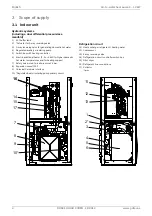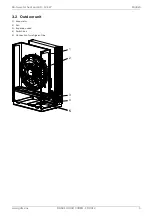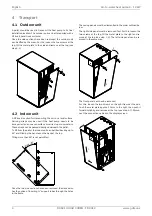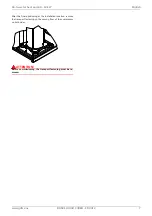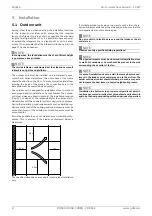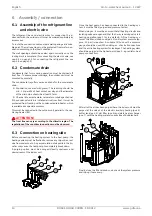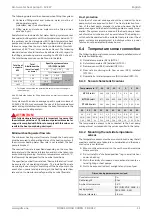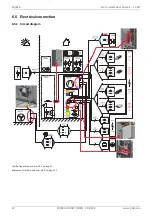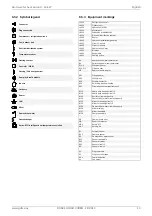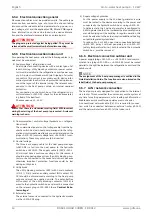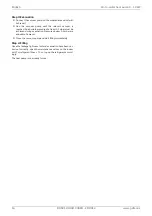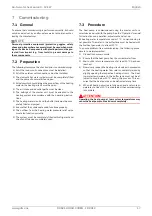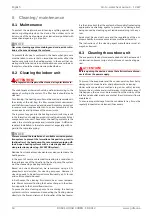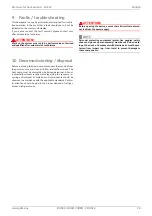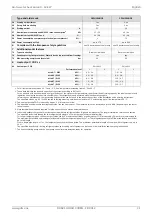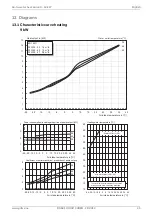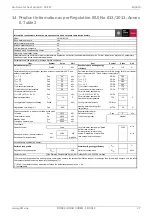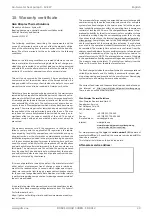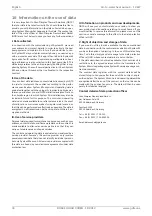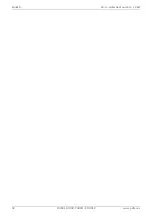
18
DOK41 HOIAO C0DEN · FD 9912
www.gdts.one
English
Air-to-water heat pump 9 - 12 kW
8 Cleaning / maintenance
8.1 Maintenance
To protect the paintwork, avoid leaning anything against the
device or putting objects on the device. The outdoor unit and
indoor unit of the heat pump can be cleaned and polished with
conventional agents, e.g. car polish.
HINWEIS
ºº
º
ºº
º
NOTE
Never use cleaning agents containing sand, soda, acid or chlo-
ride, as these can damage the surfaces.
To prevent faults due to sediment in the heat exchangers, care
must be taken to ensure that no impurities can enter either the
heat source system or the heating system. In the event that op-
erating malfunctions due to contamination occur nevertheless,
the system should be cleaned as described below.
8.2 Cleaning the indoor unit
!!
ATTENTION!
The integrated dirt trap must be cleaned at regular intervals.
The maintenance intervals should be defined according to the
degree of soiling in the system. The filter insert should also be
cleaned.
For cleaning, the heating circuit must be made pressureless in
the vicinity of the dirt trap, the filter compartment unscrewed,
and the filter insert removed and cleaned. Assembly carried out
in reverse order requires attention to correct assembly of the
screen inserts and tightness of the screw joints.
The ingress of oxygen into the heating water circuit may result
in the formation of oxidation products (rust), particularly if steel
components are used. These enter the heating system via the
valves, the circulating pumps and/or plastic pipes. A diffusion-
resistant installation is therefore essential, especially with re-
gard to the complete piping.
HINWEIS
ºº
º
ºº
º
NOTE
We recommend the installation of a suitable corrosion protec-
tion system to prevent the formation of deposits (e.g. rust) in
the liquefier of the heat pump. We recommend equipping dif-
fusion-open heating systems with an electrophysical corro-
sion protection system (e.g. ELYSATOR system).
Residue from lubricants and sealants may also contaminate the
heating water.
In the event of severe contamination leading to a reduction in
the performance of the liquefier in the heat pump, the system
must be cleaned by a heating technician.
Based on current information, we recommend using a 5 %
phosphoric acid solution for cleaning purposes. However, if
cleaning needs to be performed more frequently, a 5 % formic
acid solution should be used.
In both cases, the cleaning fluid should be at room tempera-
ture. We recommend flushing the heat exchanger in the direc-
tion opposite to the normal flow direction.
To prevent acidic cleaning agents from entering the heating
system circuit, we recommend connecting the flushing device
directly to the flow and return of the liquefier of the heat pump.
It is then important that the system be thoroughly flushed using
appropriate neutralising agents to prevent any damage from
being caused by cleaning agent residue remaining in the sys-
tem.
Acids must be used with care and the regulations of the em-
ployers liability insurance associations must be adhered to.
The instructions of the cleaning agent manufacturer must al-
ways be observed.
8.3 Cleaning the outdoor unit
The evaporator, fan and condensate drain should be cleaned of
contamination (leaves, twigs, etc.) before each new heating pe-
riod.
!!
ATTENTION!
Before opening the device, ensure that all circuits are discon-
nected from the power supply.
To prevent the evaporator and the condensate tray from being
damaged, do not use hard or sharp objects when cleaning.
Under extreme weather conditions (e.g. snow drifts), ice may
form on the air intake and air outlet areas in individual cases. If
this happens, the ice must be removed from the vicinity of the
intake and air outlet area to ensure that the minimum air flow is
maintained.
To ensure proper drainage from the condensate tray, it must be
regularly inspected and cleaned, if necessary.

